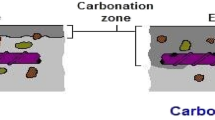Abstract
Design of corrosion free service life of concrete structures using Monte Carlo technique is presented. Most current service life models of reinforced concrete structures subject to chloride attack provide only a single deterministic time to onset of corrosion. Probabilistic modeling of corrosion is difficult to understand, tediously slow to compute and of limited value due to strong dependency on the assumed input parameters. Using Monte Carlo technique, the sensitivity on time to onset of corrosion to changes in the main parameters of corrosion model can be illustrated. Both mean and standard deviation of the time to onset of corrosion can significantly be increased if chloride diffusion coefficient of concrete could be reduced. This paper shows the variability and sensitivity on estimation of the time to onset of corrosion using Monte Carlo technique. In addition, monographs that show the required depth of cover for concrete structure to ensure 100 years of corrosion free service life are provided for preliminary design.
Similar content being viewed by others
References
Alonso, C., Andrade, C., Castellote, M., and Castro, P. (1999). “Chloride threshold values to depassivate reinforcing bars embedded in a standardized OPC mortal.”Cement and Concrete Research, Vol. 30, pp. 1047–1055.
Bamforth, P. (1993). “Concrete classification for R.C. structures exposed to marine and other salt-laden environments.”Structural Faults and Repair-93, Edinburgh.
Baroghel Bouny, V., Chaussadent, T., and Raharinaivo, A. (1995). “Experimental investigations uon bnding of chloride and combined effects of moisture and chloride in cementitious materials.” RILEM International Conference,Chloride Penetration into Concrete, Paris.
Collepardi, M., Marcialis, A., and Turriziani, R. (1972). “Penetration of chloride ions into cement pastes and concrete.”Journal of the American Ceramic Society, Vol. 55, No. 10, pp. 534–535.
Diab, H., Bentur, A., Heitner-Wirguin, C., and Ben-Dor, L. (1988). “The diffusion of Cl-ions through Portland cement and Portland cement-polymer pastes.”Cement and Concrete Research, Vol. 18, pp. 715–722.
Funahashi, M. (1990). “Predicting corrosion-free service life of a concrete structure in chloride environment.”ACI Material Journal, Vol. 87, No. 6, pp. 581–587.
Higgins, D.D. (1995). “The effect of some test variables on chloride profiles.” RILEM International Conference,Chloride Penetration into Concrete, Paris.
Luciano, J. and Miltenberger ({dy1999}). “Predicting chloride diffusion coefficients from concrete mixture proportions.”ACI Material Journal, Vol. 96, No. 6.
Luping, T. (1995). “On chloride diffusion coefficients obtained by using the electrically accelerated methods.” RILEM International Conference,Chloride Penetration into Concrete, Paris.
Luping, T. and Nilsson, L.O. (1992). “Chloride Diffusivity in High Strength Concrete at Different Ages.”Nordic Concrete Research, Pub. No. 11(1), pp. 162–171.
Luping, T. and Nilsson, L.O. (1992). “Rapid determination of chloride diffusivity in concrete by applying an electric field.”ACI Materials Journal, Vol. 49, No. 1, pp. 49–53.
Pfeifer, D.W., Landgren, J.R., and Zoob, A. (1987).Protection System for New Prestressed and Substructure Concrete, FHWA, Report No. FHWA/RD-86/193, Wiss, Janney, Elstner Associates, Inc., Springfield, VA.
Polder, R.B. (1995). “Chloride diffusion and resistivity testing of five concrete mixes for marine environment.” RILEM International Conference,Chloride Penetration into Concrete, Paris.
Vennesland, O. and Gautefall, O. (1995). “Chloride penetration into concrete exposed to severe marine environment.” RILEM International Conference,Chloride Penetration into Concrete, Paris.
Weyers, R.E. (1993).Concrete Bridge Protection and Rehabilitation: Chemical and Physical Techniques, Service Life Estimate SHRP, Report No. SHRP-S-668 Virginia Polytechnic Inc. and State Univ., Springfield, VA.
Zhang, T. and Gjorv, O.E. (1995). “An electrochemical method for accelerated testing of chloride diffusivity in concrete.” RILEM International Conference,Chloride Penetration into Concrete, Paris.
Author information
Authors and Affiliations
Corresponding author
Rights and permissions
About this article
Cite this article
Shim, H. Design & analysis of corrosion free service life of concrete structures using Monte Carlo method. KSCE J Civ Eng 9, 377–384 (2005). https://doi.org/10.1007/BF02830628
Received:
Accepted:
Issue Date:
DOI: https://doi.org/10.1007/BF02830628




